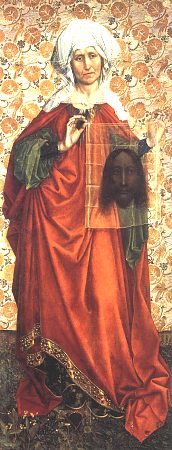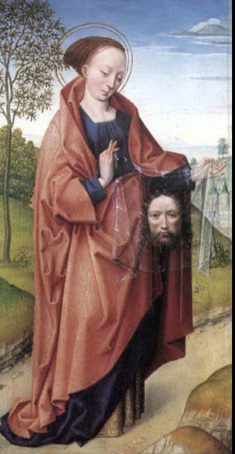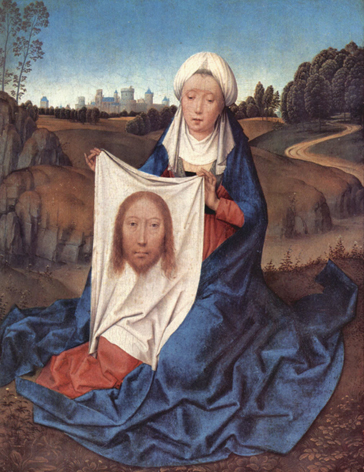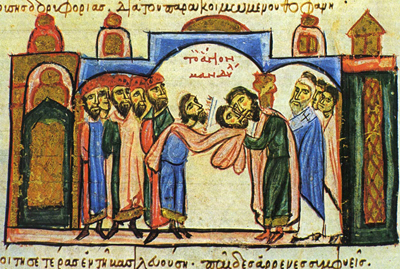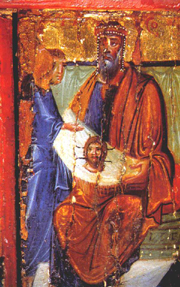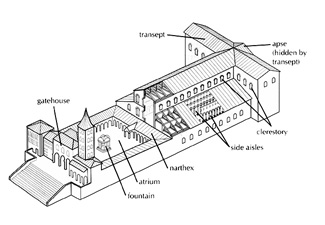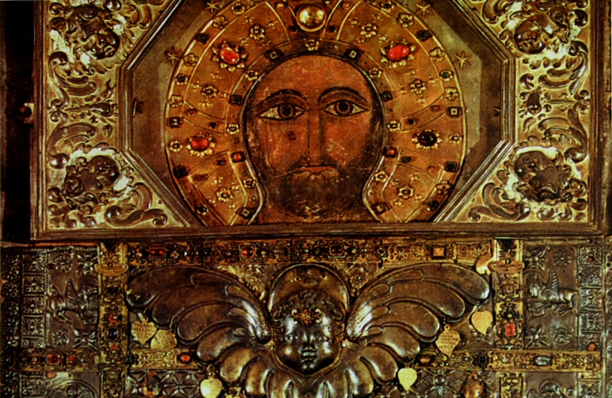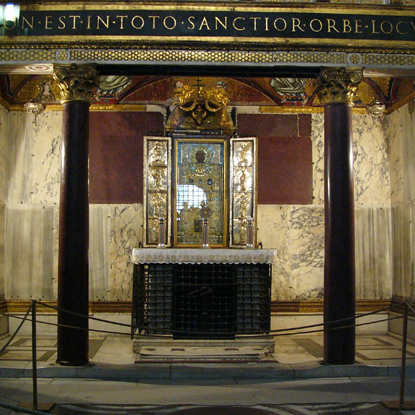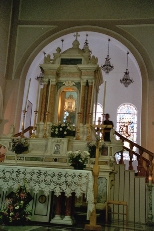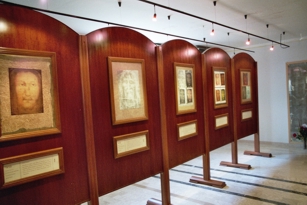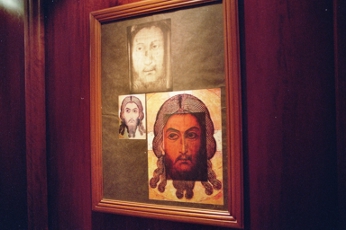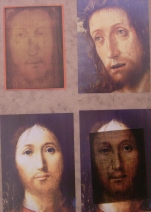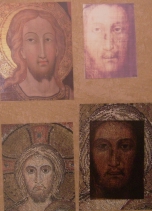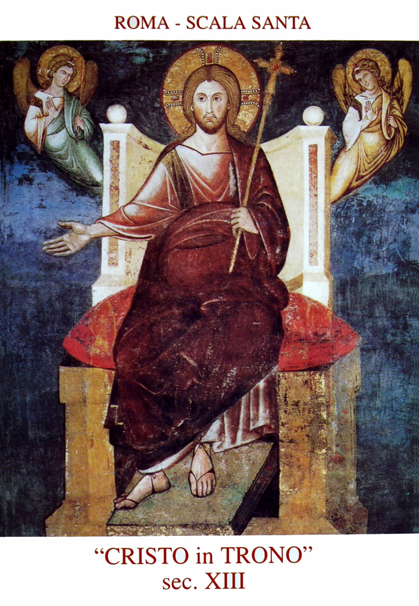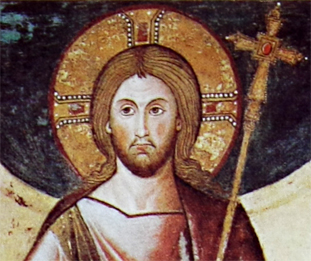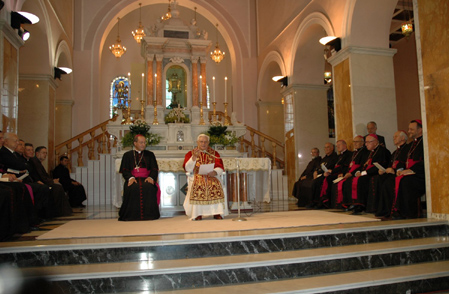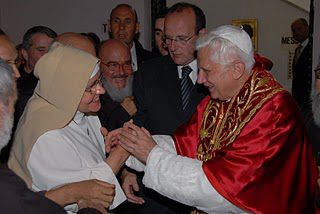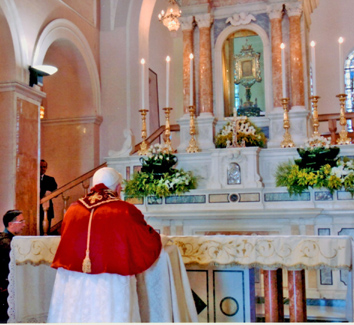|
|
||||
 |
||||||
The Volto Santo of Manoppelloremember John 20, 6-7: "6Then Simon Peter came, following him, and went into the tomb. He saw the linen wrappings lying there, 7and the cloth that had been on Jesus’ head, not lying with the linen wrappings but rolled up in a place by itself“ |
||||||
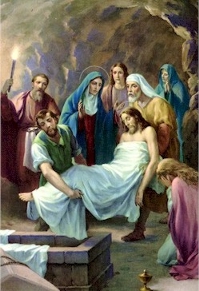 |
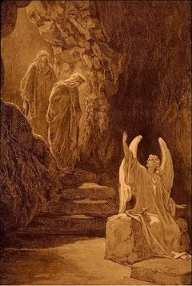 |
|||||
|
The so-called Volto Santo shows the image of Jesus on a delicate fabric veil made of silk mentioned in the Gospel of John "the cloth that had been on Jesus head". The Volto Santo is a 17.5 cm wide and 24 cm high veil that is stored in Manoppello since 1638 in the Capuchin church of Santuario del Volto Santo outside of the city.
|
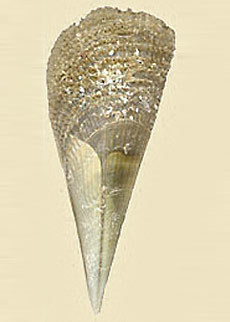 |
|||
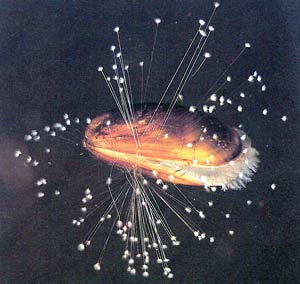 |
|||
|
|
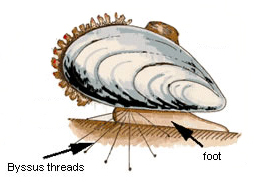 |
|
Byssus filaments . |
|
The veil shows the face of a man with long hair, beard, open eyes and the mouth slightly open. A amazing peace can be seen in his face. No despair, no pain and no anger can be seen. It seam to be the face of a man who had just woken up from sleep looking into a new morning... The face is visible from both sides of the cloth and it is so fine that you can read a newspaper through it. The veil is almost as transparent as clear glass in back light. In contrast to the shroud of Turin the Volto Santo is not been acting like a negative it acts more like photo slide. Scientist said that this image has quite mysterious characteristic. |
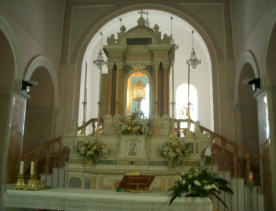 |
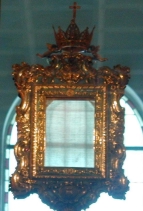 |
||||||||
|
The transparent veil can only be seen in back light. During daylight it is almost not visible (right image). You can read a newspaper through it. |
|||||||||
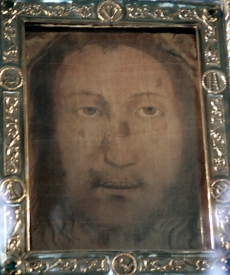 |
|||||||||
|
The holy face, the Volto Santo |
|||||||||
|
Sister Blandina Paschalis Schlomer - German Trappistine nun and iconographer living now in Manoppello claimed that the image of the Shroud of Turin and that of the Veil are super imposable. There are tufts of hair on the forehead and the face has long hair, beard and mustache with a long nose that appears to have broken cartilage like the Holy Shroud image. There are dark red features and open eyes and the figure is asymmetrical like someone beaten and swollen.
He analysed the relic of Manoppello under different points of view and published his results together with Werner Bulst in the German book: Das Turiner Grabtuch und das Christusbild, Bd. 2: Das Grabtuch, der Schleier von Manoppello und ihre Wirkungsgeschichte in der Kunst, Frankfurt/Main 1991.
The Volto Santo became world-wide famous through Mr. Paul Badde a Vatican correspondent for the German news paper “DIE WELT”. He has summarized the latest research on the image of Jesus and also added own research. This can be read in the incredibly fascinating book (available in english language): The Face of God: The Rediscovery of the True Face of Jesus; Publisher: Ignatius Press (October 30, 2010)
|
|
Photo by Paul Badde |
|||||
|
Since 1712 every third Sunday in May, a solemn procession takes place in which the cloth is carried through the streets of Manoppello. Many thanks to Mr. Paul Badde for permission to publish his photos on my website! |
|||||
|
Historical legends
The legend runs as follows: Abgar, king of Edessa, afflicted with an incurable sickness, has heard the fame of the power and miracles of Jesus and writes to Him, praying Him to come and heal him. Jesus declines, but promises to send a messenger, endowed with His power, namely Thaddeus (or Addaï), one of the seventy-two Disciples. The brought an image of Jesus to king Abgar (the mandylion of Edessa). For more information (only German language) see link Abgarlegende The legend of the Veil of Veronica In Catholic Churches around the world we find an early practice formalized much later called the Stations of the Cross (14 of them) which walk through various incidents during the passion and death of our Lord. The Church dedicates the Sixth Station to Veronica Wipes The Face of Jesus. Is this an actual event and what do we know of the Veil on which Jesus is believed to have left His image? For more information (only German language) see link Schweißtuch_der_Veronika |
|
|
|
|
||||||||||||||||||||||||||||||||||||||||||||||||||||||||||||||||||||||||||||||||||||||||||||||||||||||||||||||||
|
The Veronica Legend relates that while Jesus was on the Via Dolorosa going to His Crucifixion, a woman stepped out of the crowd and, out of love and compassion, wiped His face of sweat and blood with her Veil. As a reward, Jesus left the imprint of His face on the Veil. That Veil is believed to have passed down to us through a long, convoluted history. Today, there are two claims to having the Veronica Veil. One is by the Vatican in St. Peter's Basilica in Rome. The other claims the true Veronica is in a Capuchin Monastery about 150 miles east of Rome in the Apennine Mountains of Manoppello - it having been lost (stolen) from the Vatican in the 16th century during renovations and brought eventually to Manoppello.
The Sudarium of Oviedo The Sudarium of Oviedo, or Shroud of Oviedo, is a bloodstained cloth, measuring c. 84 x 53 cm, kept in the Cámara Santa of the Cathedral of San Salvador, Oviedo, Spain. The Sudarium (Latin for sweat cloth) is claimed to be the cloth wrapped around the head of Jesus Christ after he died, as mentioned in the Gospel of John (20:6-7). It was used to stop blood flow from his face. Many of the stains on the Sudarium match those on the head portion of the Shroud. Pollen residues on both the Shroud of Turin and the Sudarium provide strong evidence that both were at one point in the Palestine area. The most important physical evidence of a connection between the two relics is that the material of the cloth is identical, although there are differences in the manner of weaving and the blood on both relics are from the same person. |
 |
|||
|
Das Schweißtuch der San Salvador-Kathedrale in Oviedo |
|||
|
The Volto Santo in the city walls of Edessa The Volto Santo has been found together with the "shroud of Turin" in the year 525 in the city walls of Edessa. It played an important role during the siege of that city in the year 544, as the historian Evagrius scholasticus wrote in the year 594: "When they were completely lost, they brought the veil which was created by God and not made by human hands ... ". Since that time, this image was used as baseline for countless icons and images of Christ. In the year 574 the Volto Santo came to Constantinople. |
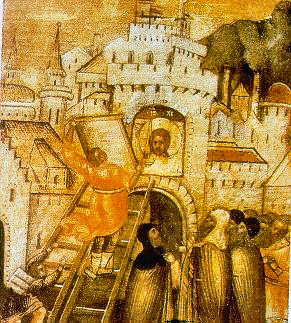 |
|||
|
Auffinden des Volto Santo in den Stadtmauern von Edessa im Jahre 525 |
|||
|
The most precious relic of Christianity found in Manoppello? All evidence show that the Volto Santo must be the so-called veil of Veronica. It is believed that the relic was keept in the old St. Peter's Basilica until the year 1608. Millions of pilgrims traveled to Rome only because they wanted to see the veil of Veronica (the holy face). You can imagine what happed when they recognized that the veil was disappeared, shortly before the veil should be placed in the specially designed safe in the pier of the Veronica. It was decided to establish a kind of dummy or fake image to continue to maintain flow of pilgrims to Rome. Historians asked them self why the pilgrims in the 16th Century suddenly stopped. But with this background we now have found an explanation for the behavior of the pilgrims. Historical records: Later history records that, during the Iconoclastic debates in the 8th century when Icons were threatened, the Veronica was brought to Rome in 708 A.D. by the Emperor Germanus for temporary safe-keeping and remained there with the fall of the Byzantine Empire. The assumption is made by later writers that Veronica was present in the Old St. Peter's (built by Constantine the Great circa 325) in the papacy of John VII (705-708) in a Chapel called the Veronica Chapel built during his reign. In 753 a procession was recorded with Pope Stephen II carrying an "Acheropsita" - that is, an icon on which a painted veil was placed known at the time as the Holy Face of the Sancta Sanctorum Chapel in the Pope's Palace in Laterano - likely, according to Pfeiffer, the Holy Face now in Manoppello. |
|
|
||||||||||||||||||||||||||||||||||||||||||||||||||||||||||||||||||||||||||||||||
|
Firm recording of Veronica only begins in 1199 when two pilgrims Gerald de Barri (Giraldus Cambrensis) and Gervase of Tilbury made two accounts at different times of a visit to Rome which made direct reference to the existence of the Veronica. From 12th Century until 1608 the Veronica was kept in Vatican Basilica as a popular goal of pilgrims. In 1297 by order of Pope Boniface VIII, the image was brought to St. Peters'. In the Holy Year 1300 the Veil publicly displayed and became one of "Mirabilia Urbis" (wonders of City) for pilgrims. Dante mentioned in Divine Comedy-Paradiso, Canto XXXI (verses 103-111) - the people coming to Rome to see the Veil.' During the fourteenth century it became a central icon in the Western Church - in the words of Art Curator Neil Macgregor "From the 14th century on, wherever the Roman Church went, the Veronica would go with it." |
|
Then, during a remodeling of St. Peter's Basilica, Professor Pfeiffer says the Veil was stolen from the Vatican and brought, eventually, to Manoppello. wrote a "Relazione Istorica." |
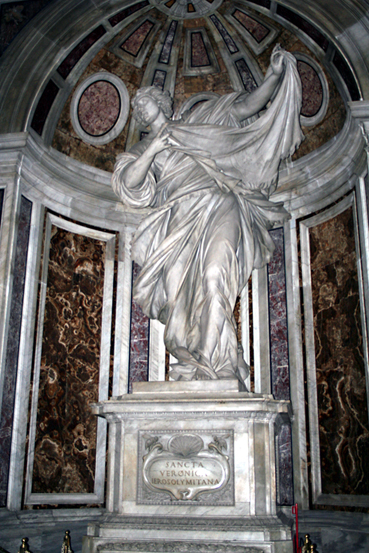 |
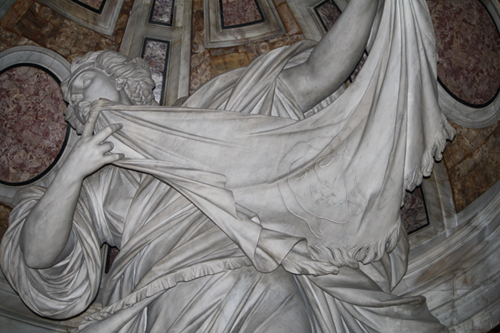 |
||||||||||||||
|
Pier of St Veronica (detail) |
|||||||||||||||
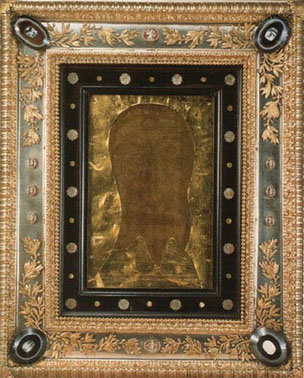 |
|||||||||||||||
|
Pier of St Veronica, Roma |
|||||||||||||||
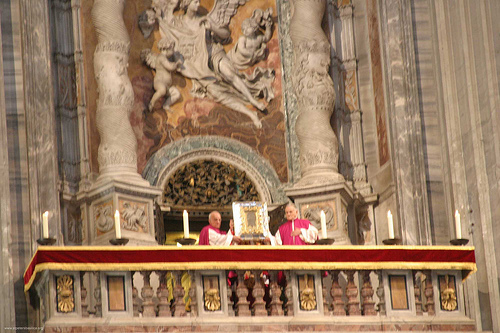 |
|||||||||||||||
|
Paul Badde konnte dieses Bild am 1. Sept. 2004 im Veronikapfeiler sehen und berichtet, dass man darauf kaum mehr etwas sehen könne! |
|||||||||||||||
 |
|||||||||||||||
|
|
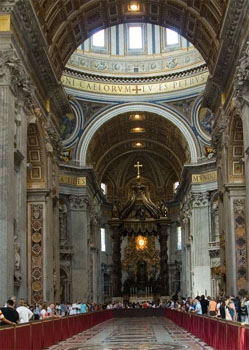 |
|||||
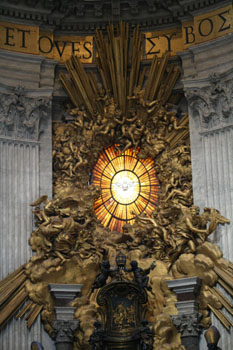 |
|||||
|
Representation of the Holy Spirit in St. Peter's (Rome). Perhaps theVolto Santo was shown in place of the Holy Spirit in the past as Paul Badde suspected? |
|||||
|
The claim is made that in 1506- as preserved in the Capucine Provincial Archive - a mysterious stranger (maybe a angel) brought the Veil to Manoppello in 1506 and gave it to a gentleman of the place, Dr. Giacomo Antonio Leonelli. The precious veil was kept in the family for over a century. Then, in 1608, it was included in the nuptial gifts for Maria Leonelli for 400 scudi (an old Italian unit of currency) , but the gift was never delivered. In 1608 Maria's husband, Pancrazio Petrucci stole it from his father-in-law's home. Later, in order to have her husband released from prison in Chieti, she sold the veil to Dr. Donato Antonio De Fabritis who placed it in a Walnut Frame adorned with Silver and gold between two pieces of glasses and presented it to the Capuchins in 1638 as recorded in 1640 by Padre Donato from Bomba. |
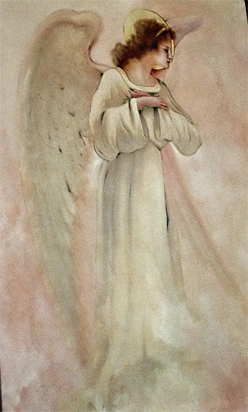 |
||||||||
|
Gemälde eines Engels in der Basilika von Manoppello. |
||||||||
|
The testimony of Manoppello Father Donald Bomba wrote on 06/april/1646 the following documentation about the appearance of the veil in Manoppello in the area of Abruzzo in Pescara, italy: "In the year 1506 on a Sunday afternoon, doctor Giacomo Antonio Leonelli, a physicist and scholar of the liberal arts was in front of the church of St. Nicholas of Bari in Manoppello. A stranger approached him and gave him a packaged and recommended that he should keep it with reverence, because it is a very precious thing. Dr. Leonelli removed the wrapping and held the veil image in his hands. He looked to the stranger to ask for information, but he was amazed, the stranger had disappeared without a trace. Dr. Leonelli was searching everywhere for him, but he couldn't find him. The mysterious stranger was untraceable. Later people said that it could only have been an angel, because only angels were only able to dematerialize them self ." for more information the link (German language) Volto-Geschichte |
||||||||
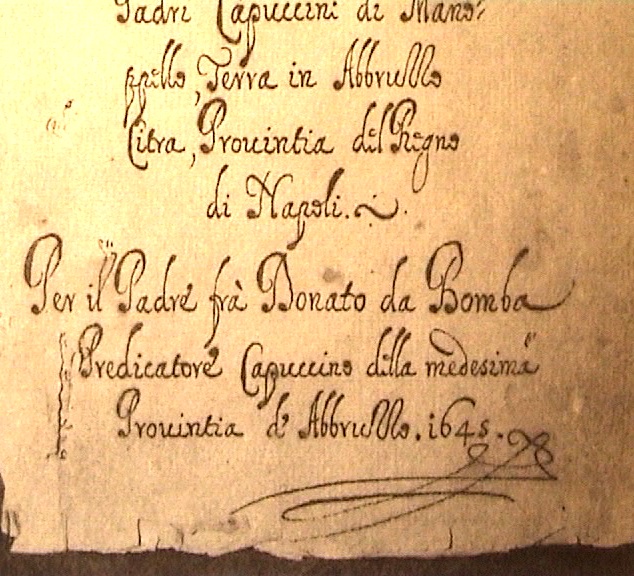 |
||||||||
|
Father Donald Bomba wrote on 06/april/1646 the following documentation |
||||||||
|
Now, only 500 years later after the disappearance of the veil in Rome, it seems to be clear that the veil is found in Manoppello. No one thought that this would be possible. The veil being shown today at the Vatican, can't be the real Veronica. It is the fake image which was produced 400 year ago (today there can't be seen an image any more). The Capuchins are probably the only for that reason in Manoppello, to keep this veil with the image of Christ over the centuries. Prof. Dr. Heinrich Pfeiffer is sure that the veil of Manoppello is the ancient relic to the holy face of Jesus! |
|
|
|
||||||||||||||||||||
|
Scientific research on the Volto Santo, the veil of Manoppello The scientists believe that the color of the veil originated my a unknown process within the fibers itself. The gradient on the veil material is completely seamless. Microscopic analysis showed that there are no color pigments or other deposits that would be relevant for the image formation. No capillary flow was found on the fibers what would have been impossible to prevent when the colors would have been applied with a brush by a artist. However in some areas of the picture for example in the pupil pigments have been found. Those pigments may have been added by a medieval painter in order to refresh the color after many years. |
 |
|||||
|
mouth area of the veil |
|||||
|
Has the image perhaps been applied before weaving the fibers? In that case all fibers would have been individually colored before the weaving process started. This is totally impossible. In correct lightning the shade of color can be found on both the warp and weft of the threads! The veil image also has a 3-dimensional effect which is dependent on the type of lighting and the position of the viewer (in local and spiritually). There are many other hypotheses in science. All whant to find in a plausible explanation for this image. In a first step science thought that this picture was the work of a skilled artist, but after many hours of work and analysis scientists, artists, scholars from various disciplines are sure that this image is not made by human hands. Kurt Walter Zack, a Swiss architect who worked intensively with the Volto Santo said. "If the veil of Manoppello is a human work, than it is a true miracle of technology". Other scientist agreed this point of view. But there's more to report about the veil. The veil has behaviour like a photo slide. The veil image is equall visible from the front and back side (no
differents in the shade of color). The two sides of the image are absolutely identical. If this image would have been produced by a artist, we would find some differents on both images. But not any differences could
be found which would led to a artist. Secondly, the veil is amazing congruent with the shroud of Turin. see link (German language) Sopraposition |
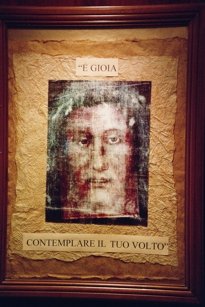 |
|||||
|
The Volto Santo is congruent with the shroud of Turin. Displayed in the information area of the basilica in Manoppello. |
|||||
|
The "archetype" of all the icons |
|
|
||||||||||||||||||||||||||||||||||||||||||||||||||||||||||||||||||||||||||||||||||||||||||||||||||||||||||||||||||||||||||||||||||||||||||||||||||||||||||||||||||||
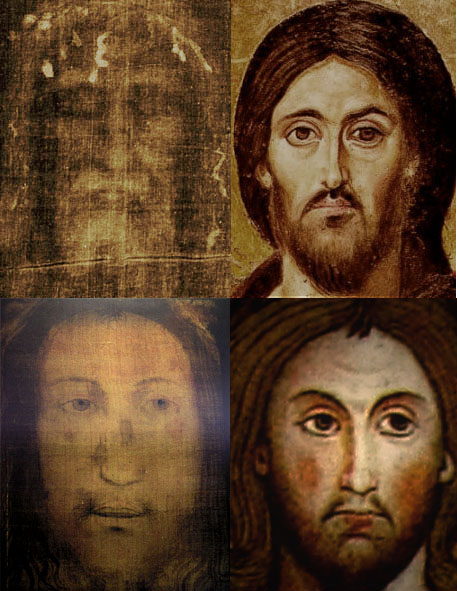 |
|
Shroud of Turin, Pantocrator at Saint Catherine's Monastery (Sinai), Volto Santo from Manoppello, Scala Santa in Rome |
|
Pope Benedict XVI made a pilgrimage to Manoppello |
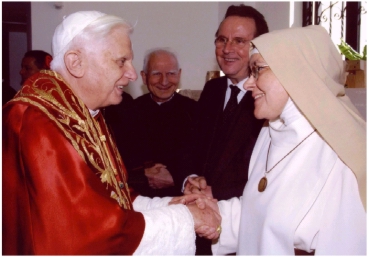 |
|||
|
The Pope welcomes Sister Blandina in Manoppello. In the background: Mr. Paul Badde right, left, Prof. Dr. Pfeiffer |
|||
|
The Pope arrived by helicopter and was welcomed at the Shrine by the priests and Religious of the Archdiocese, led by Archbishop Bruno Forte
who greeted the Holy Father and presented various gifts to him. Benedict prayed at the shroud for a few minutes, saying he wants to "better know the face of our Lord." Then he looked at the glass shrine to
view the Volto Santo in detail. To see the true face of Jesus we have to be lead by his Spirit. Who ever met Jesus will understand his words “Very truly, I tell you, unless a grain of wheat falls into the earth and dies, it remains just a single grain; but if it dies, it bears much fruit.“ (John 12, 24). ”This is a place where we can meditate on the mystery of divine love, while we look at the holy face of Jesus" the Pope said to his priests and theological students. "We urgently need to search for the face of God and learn to know it" he said at the church to ten thousand pilgrims who spent the day in Manoppello.
|
|
|
||||||||||||||||||||||||||||||||||||||||||||||||||||||||||||||||
|
Whoever has seen me has seen the Father (Joh. 14, 9) |
|||
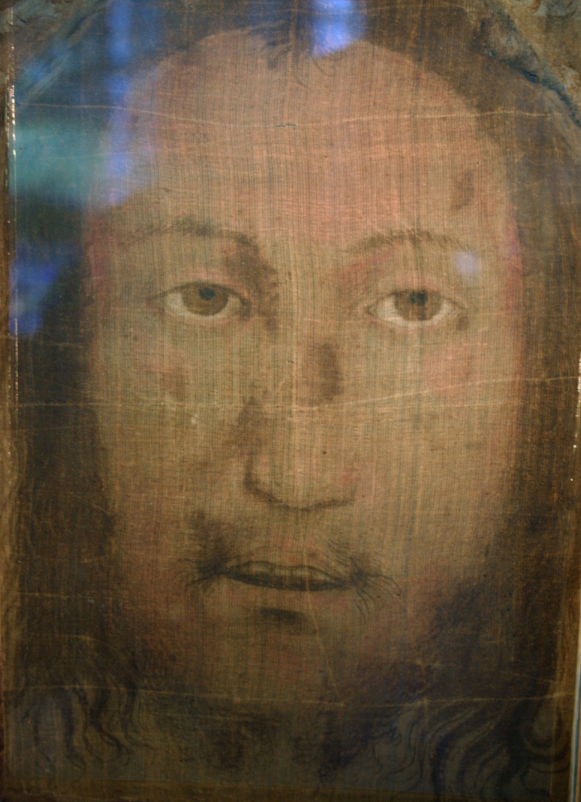 |
|||
